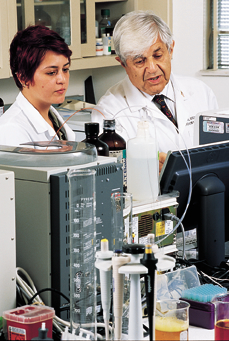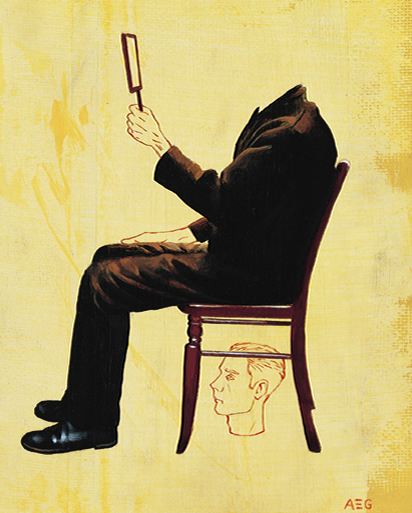
For years the diagnosis |
|
 ike death and taxes few things in life seem
as certain as a fading memory. You may notice it after misplacing your
car keys for the third
time in the same day, or when you forget whether you ordered the chicken
or fish the night before. Or perhaps you realize that no matter how hard
you try you can’t recall the name of that boy your daughter keeps
bringing home for dinner. What is not certain is how soon your memory
will begin to fade, how much you will lose, and what causes it to flicker
in the first place.
ike death and taxes few things in life seem
as certain as a fading memory. You may notice it after misplacing your
car keys for the third
time in the same day, or when you forget whether you ordered the chicken
or fish the night before. Or perhaps you realize that no matter how hard
you try you can’t recall the name of that boy your daughter keeps
bringing home for dinner. What is not certain is how soon your memory
will begin to fade, how much you will lose, and what causes it to flicker
in the first place.
Indeed our understanding of human memory—how it is constituted
and how it falters—remains riddled with assumption and conjecture.
There is still much that we do not know. But as with other fields of
study delving
into the murky recesses of the brain, research into the causes and treatment
of memory disorder, or dementia, is advancing at a rate unimaginable
only a few years ago. Today drug therapies can slow the progression of
Alzheimer’s
disease, and other debilitating memory disorders are proving treatable.
Physicians now believe that future therapies will repair faulty synapses
and even coax the brain into regenerating neurons—the nerve cells,
once thought to be finite in number, that serve as building blocks for
memory. Meanwhile researchers continue to recognize both physiological
and psychological predictors for memory disorders. Such cues are helping
clinicians identify diet, lifestyle, and education guidelines for developing
and maintaining a healthy memory from childhood through old age.
![]() he
University of Miami School of Medicine is home to national leaders
of research into
the
neurological causes and treatments of memory disorders. With a growing
elderly population in South Florida, the region is an ideal setting for
studying Alzheimer’s disease and other forms of dementia. And
a $5 million grant from the McKnight Brain Research Foundation will enable
UM to increase its efforts. Earlier this
year the School of Medicine announced the creation of the Evelyn F. McKnight
Center for Age-Related Memory Loss. When fully staffed and operational,
the center will be among few of its kind in
the nation.
he
University of Miami School of Medicine is home to national leaders
of research into
the
neurological causes and treatments of memory disorders. With a growing
elderly population in South Florida, the region is an ideal setting for
studying Alzheimer’s disease and other forms of dementia. And
a $5 million grant from the McKnight Brain Research Foundation will enable
UM to increase its efforts. Earlier this
year the School of Medicine announced the creation of the Evelyn F. McKnight
Center for Age-Related Memory Loss. When fully staffed and operational,
the center will be among few of its kind in
the nation.
Estimates of the number of Americans suffering from memory disorders are hard to pin down. Public health officials say the number afflicted with Alzheimer’s may top five million, but some studies suggest the actual count may be much higher because of the difficulty in diagnosing the disease, especially in its early stages. A smaller number may experience dementia brought on by a variety of other conditions including Parkinson’s disease, Pick’s disease, traumatic brain injury, and stroke. Memory loss also may result from alcoholism or vitamin deficiencies, as well as lifestyle and environmental factors. There also appears to be a genetic link with some forms of memory dysfunction.
In many more cases, the pathophysiology of memory loss remains a mystery. The great majority of elderly patients who experience occasional forgetfulness, and for whom specific diseases such as Alzheimer’s can be ruled out, are diagnosed with “mild cognitive impairment” or MCI. The condition is sometimes called “age-related memory loss” or “benign senescent forgetfulness.” To some experts, the condition is a normal part of aging, like wrinkles and gray hair. But to others it is a precursor to Alzheimer’s or other forms of dementia or it may be a slow degenerative disease of its own.
“ This is really the key question,” says Rodrigo Kuljis, M.D., the Esther Lichtenstein Professor of Neurology and Psychiatry at the School of Medicine and an expert on memory disorders. “Is mild cognitive impairment something that happens to all of us when we get old, and therefore should be largely ignored? Or is it a disease for which we should search for treatment?” The difficulty of MCI diagnosis will be among the problems addressed at the McKnight Center.
“ There is one school of thought that aging and its manifestations are programmed into us from the moment we are conceived,” says Walter Bradley, D.M., F.R.C.P., chairman of the Department of Neurology and a renowned expert in neurological research and treatment. “But another school believes that aging should be viewed as a disease, and if we can cure aging we can live, theoretically, forever.”
Although the jury is still out, consensus appears to be building that MCI may be a treatable, perhaps curable and preventable, disease. According to Bradley, we do know that MCI is not always a kind of Alzheimer’s-lite: in some MCI sufferers, a different biological process is at work. In some cases, patients with mild memory dysfunction may develop Alzheimer’s, but it is unclear whether MCI predisposes the brain to the disease.
![]() he debate
over age-related memory loss is understandable, given how much scientists
do not yet know about
the physiological basis for memory.
Researchers are fairly certain that memory traces, or engrams, are produced
by a complex
neurochemical code within the brain’s hippocampus. Here the traces
exist in a kind of “working memory” but are not permanent.
They are transferred to the cerebral cortex and, in some cases, other
storage areas of the brain for future retrieval. Consequently, patients
with injuries
to the hippocampus can lose their ability to acquire and lay down new
information, yet their ability to retrieve previously stored data remains
intact
he debate
over age-related memory loss is understandable, given how much scientists
do not yet know about
the physiological basis for memory.
Researchers are fairly certain that memory traces, or engrams, are produced
by a complex
neurochemical code within the brain’s hippocampus. Here the traces
exist in a kind of “working memory” but are not permanent.
They are transferred to the cerebral cortex and, in some cases, other
storage areas of the brain for future retrieval. Consequently, patients
with injuries
to the hippocampus can lose their ability to acquire and lay down new
information, yet their ability to retrieve previously stored data remains
intact
 |
||
 |
||
Whatever the case, it is widely accepted that neuron death is the principal culprit behind most memory loss. What is not as certain is what causes the neurons to die. Autopsies of Alzheimer’s patients reveal a telltale mass of neural debris clouding the cortex. But why do some people develop the disease and not others? There is a genetic link, but other factors can increase the odds. According to Bradley, repeated traumatic brain injury may be a risk factor for developing Alzheimer’s disease later in life. New research into Alzheimer’s is focusing on the synapses that form connections between neurons. Some investigators suspect that overproduction of a protein (amyloid) may attach to the cell wall, interfering with the synapses, thus rendering the neurons useless and causing them to die. If proven, future therapies would target amyloid, either with drugs or by prodding the immune system into producing antibodies against the killer protein.
 ile
the cause of Alzheimer’s remains in question, there is little
doubt that lifestyle, education, health complications and, to a degree,
diet are linked to memory dysfunction. In general, explains Dalton
Dietrich, Ph.D., scientific director at the School of Medicine’s
Miami Project to Cure Paralysis, any time normal blood flow to the
brain is impeded, there is risk of cell damage resulting in memory
disorders. In research studies likely to be undertaken at the McKnight
Center, Dietrich will work to develop a technique to lower a patient’s
core body temperature after head injury, cardiac arrest, stroke, and
other such events as a way to reduce the loss of brain cells.
ile
the cause of Alzheimer’s remains in question, there is little
doubt that lifestyle, education, health complications and, to a degree,
diet are linked to memory dysfunction. In general, explains Dalton
Dietrich, Ph.D., scientific director at the School of Medicine’s
Miami Project to Cure Paralysis, any time normal blood flow to the
brain is impeded, there is risk of cell damage resulting in memory
disorders. In research studies likely to be undertaken at the McKnight
Center, Dietrich will work to develop a technique to lower a patient’s
core body temperature after head injury, cardiac arrest, stroke, and
other such events as a way to reduce the loss of brain cells.
For similar reasons, proper exercise and diet are vital to maintaining a healthy memory. “There is no question that good nutrition and regular exercise are essential because of the effect cardiovascular disease has on long-term cognitive functions,” says Kuljis. There appears to be a short-term effect as well. A 2002 study found that people scored higher on memory exams if they elevated their heart rates mildly before being tested, presumably because increased blood flow improves delivery of oxygen and glucose to the brain. Those findings were supported by another study showing that people who metabolize glucose more efficiently—a direct benefit of good diet and exercise—score higher on memory tests.

Not surprisingly, adds Bradley, both depression
and stress also are risk factors for memory dysfunction. It is believed
that prolonged levels of extreme stress may actually produce permanent
changes within the brain.
Perhaps the most intriguing risk factor for memory dysfunction is lack of mental stimulation. Research has shown that people who remain mentally active seem more likely to avoid memory problems later in life. Experts believe that the brain, like other parts of the body, needs to be active to remain healthy. “Use it or lose it,” says Bradley. “There’s no question that people who keep their mind busy and engaged do much better later on than people who let their minds fester in front of a television set.”
This discovery has fueled demand for memory-enhancement guidebooks and workshops. Do they work? To a degree, says Carl Eisdorfer, Ph.D., M.D., chairman of the Department of Psychiatry and Behavioral Sciences and director of UM’s Center on Aging. He says there are a number of useful strategies for improving basic memory skills—remembering names, dates, and facts, for example. What isn’t clear is whether the strategies can permanently alter the brain’s basic wiring or simply help us to better utilize our existing set of cognitive tools.
Despite the clinical uncertainty shrouding the diagnosis and treatment of memory-impaired patients, Eisdorfer and colleagues are encouraged about the future. “We’re learning new things almost every day,” says Eisdorfer. “For so long the causes of memory disorders have been a mystery to us. Now with the advances in technology and with the resources we have available, the doors are starting to open. And they’re opening at a rate that is 100 times faster than just a few years ago.”
Photography by John Zillioux.
